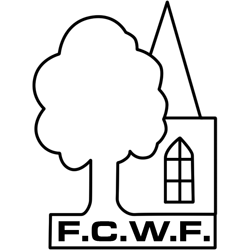The Invertebrates of Childwall Woods and Fields.
The tiny residents of the woods and fields outnumber us by millions to one but we rarely see them and know of just a few. This page will help you to get to know a few of them a little better and maybe introduce you to a few new species you didn’t know were there.
The Elder Leaf Beetle Agelastica alni
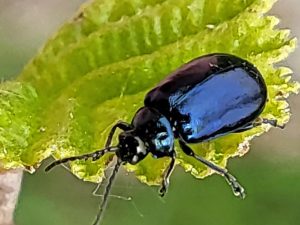
This shiny black beetle can be seen on the Alder trees in the fields. You will see whole trees with their leaves mostly in tatters where this beetle and its larvae have been feeding. The trees recover well each year to give the Alder leaf beetle a feast each spring.
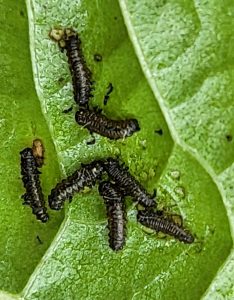
This beetle was thought to be extinct in Britain but was found in Manchester in 2004 and has spread rapidly throughout the area since then.
The Seven Spot Ladybird, Coccinella septempunctata
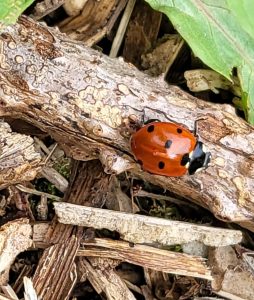
Mostly seen on the fields but likes the sunny spots in the woods too and hibernates in the leafy areas around the trees or under bark in small clusters with other ladybirds. It feeds on aphids and so it’s the gardener’s friend, and its red colour tells its predators that it doesn’t taste good and they leave it alone.
The Sputnik Spider Paidiscura pallens
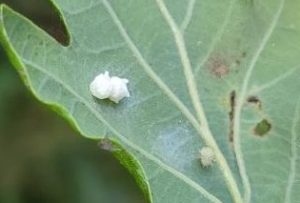
B Cameron July 22
Next time you see an oak tree turn over a leaf or two and in the summer months, you are bound to see a Sputnik spider.
This tiny green spider is the perfect mother as after laying her legs and making a tiny sputnik-shaped cocoon for them she secures them to the leaf and guards them. Can you see her in the photograph, sitting nearby making sure they are ok?
One more interesting fact about this tiny spider is that it is a comb-foot spider, and has a tiny comb on one of its feet. I wonder if that’s to make the pointed sputniks?
The Sycamore Moth Caterpillar Acronicta aceris
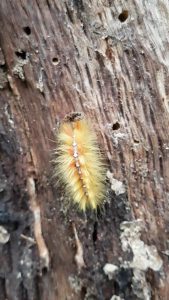
Oct 21
Rarely seen this far north, the Sycamore moth is a dull grey, unlike its caterpillar which is the brightest hairiest caterpillar in Brittain. Rarely seen this far north it was spotted climbing up the Holm oak in Childwall Woods.
The caterpillar eats maple, horse chestnut, and oak leaves. With its very bright orange hair and white spots lined in black along its back, you would be mistaken in thinking it was poisonous. It is harmless but can cause skin irritation if handled.
As this is such a rare visitor please let us know if you see one.
Hirtodrosophila confusa
In May 2022 some of the large brackets, Ganoderma Astrale were noticed by a colony of tiny fruit flies.
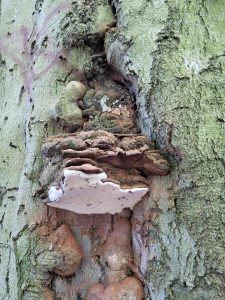
Ganoderma australe May 22
When viewed more closely they seemed to be eating and breeding on the bracket and as evening approached they would move up into the folds and fungal layers above.
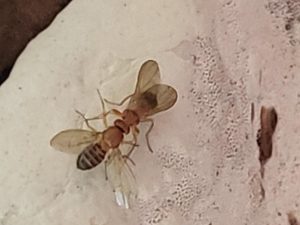
June 22
Photographs of these little visitors were sent to an eminent entomologist Paul Whitehead, who knows our site well and he identified them as Hirtodrosophila confusa, a fungus-breeding species that is known to use Ganoderma sporophores ( brackets) as assembly sites.
Paul sought the opinion of two highly experienced dipterists (fly specialists), Dr A. P. Godfrey and Dr P. Chandler, both of whom agreed with his identification.
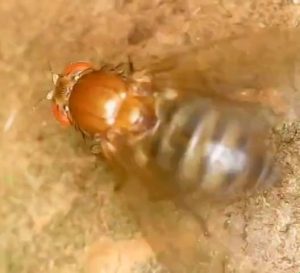
Hirtodrosophila confusa (magnified) in the folds of a bracket on Veteran Tree number 6.
Hirtodrosophila confusa is evidently a rare species with few published records in this country but is likely to be overlooked generally.
Every May as the weather becomes more clement, you will be able to see colonies of these rare little fruit flies, eating, breading and lying on the many Ganoderma tree brackets that are on our veterans throughout the woods.
The Violet Ground Beetle, Carabus violaceus
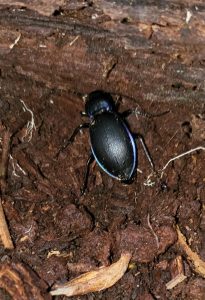
A Violet Ground Beetle Sept ’22
A dull black beetle with violet edges, this ground beetle does not fly but eats other woodland dwellers such as slugs snails and any tiny insects it can catch.
A nocturnal beetle but this one was disturbed while sleeping under leaves in a fallen branch of veteran tree number 16.
In May 2021 we had a visit from Paul F Whitehead, the eminent entomologist who helped us with the identification of the rare fruit flies above. He very kindly agreed to walk a few of the ‘Friends’ committee around the site and see what he could uncover, and there were some wonderful discoveries made.
Here are some of the finds from that day
Common Lime Aphid – Eucallipterus tiliae
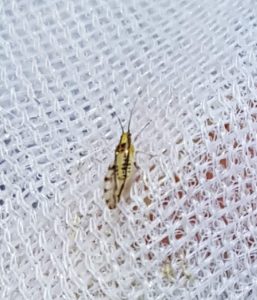
Common Lime Aphid – Eucallipterus tiliae
The common Lime Aphid is a highly distinctive species that feeds on the underside of lime leaves (Tilia spp) gathering together on the large leaf veins to feed and become part of a larger group. There’s safety in numbers.
The aphid in the photo is a winged female.
Harlequin Ladybird – Harmonia axyridis Larva
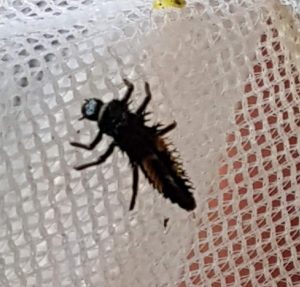
Harmonia axyridis Larva
The Harlequin ladybird larva looks quite different to the adult.
This ladybird unlike the seven-spot ladybird is considered to be a highly invasive species that may have detrimental effects on native ladybirds as they eat the eggs and larvae of other beetles.
They breed rapidly and have colonised the entire British Isles in a decade. Like many ladybirds, they eat aphids which is the reason why they were originally introduced from Asia.
The picture shows a well-developed larva.
Rove Beetles
Rove Beetles are predatory beetles typically found amongst decaying matter where they may scavenge or prey on other scavengers.
They are distinguished by their short wing covers that typically leave their abdominal segments exposed. There are roughly 63,000 species of Rove Beetles.
They are an indicator of well-developed wood rot in ancient, stable woodland systems.
Leptusa pulchella
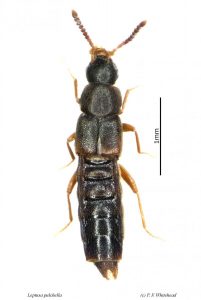
Leptusa pulchella – P. F. Whitehead
This beetle was found on the stump of a Silver Birch (Betula pendula) in the northern woods.
Melandryid Beetle – Phloiotrya vaudoueri
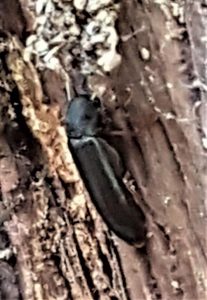
Phloiotrya vaudoueri – 13/7/21 – Holm oak
Found in Childwall Woods on the old Holm Oak (Quercus ilex) in the folly.
This beetle is recognised as an indicator of ancient woodland and is found in the better woodland sites; it is also a habitat quality indicator with a scattering of records in the north-west. This makes it of considerable conservation interest.
Two recently emerged beetles were seen under the bark together with exit holes in the heartwood
An exciting find in our woods.
Click Beetle – Denticollis linearis larva
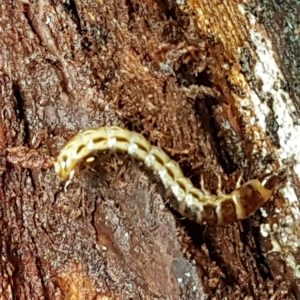
Denticollis linearis larva – 13/7/21
Found on a fallen Sycamore (Acer pseudoplatanus)
This is the larva of the click beetle Denticollis linearis.
The larvae are omnivorous, feeding beneath bark on invertebrates and decayed wood.
This species of click beetle was last recorded on Merseyside at the National Trust grounds at Speke Hall on 1st September 1985. https://records.nbnatlas.org/occurrences/search?q=lsid:NBNSYS0000010980#tab_mapView
Ptinella cavelli
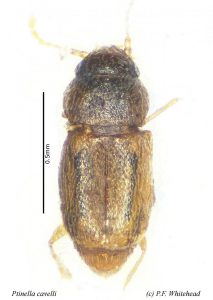
Ptinella cavelli-Childwall Woods-sycamore-2021.07.13 P F Whitehead
Discovered under the bark of a fallen Sycamore (Acer pseudoplatanus) by Countisbury Road.
A non-native beetle and one of the tiniest (centre of the photo below)
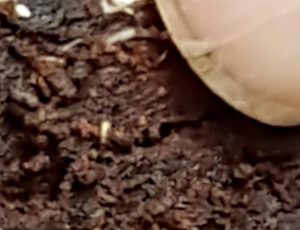
Ptinella cavelli next to a fingernail.
Fan-bearing Wood-borer – Ptilinus pectinicornis
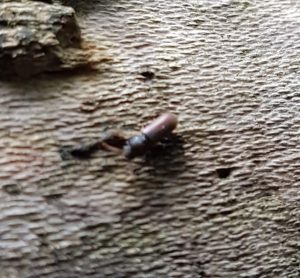
Ptilinus pectinicornis – Sycamore – 13/7/21
The Fan-bearing Wood-borer is a species of beetle in the family Ptinidae; when the antennae are raised, they spread out like a fan. A small wood-boring beetle inhabiting much of the southern half of the country.
Acompocoris alpinus
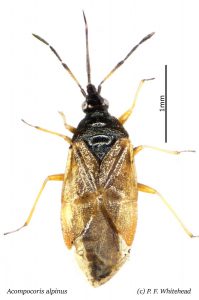
Acompocoris alpinus – Childwall Woods – 13/7/21 – P. F. Whitehead
This is one of two British species of this genus of true bugs, Hemiptera.
A. alpinus is a predatory species usually linked to pine trees especially in the Old Caledonian Pine Forest but also to planted pines and occasionally other conifers further south in Britain.
This specimen was swept from Enchanter’s Nightshade in Childwall Woods. Examples are occasionally found well away from their host trees and even in more open country.
There are no previous records of this beetle in the northwestern region.
Author: B Cameron
Edited by Paul F. Whitehead.
All images are the authors’ own unless stated otherwise.

